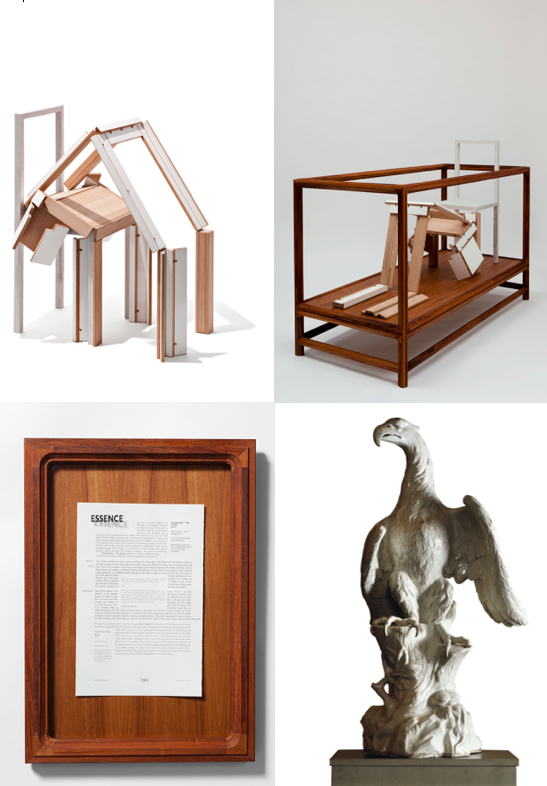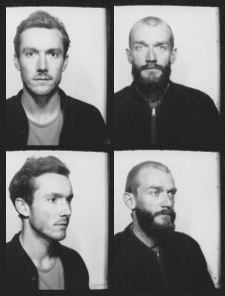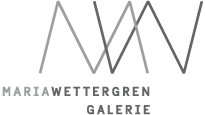
ESSENCE
ESSENCE can be an elusive quality. The Outsider/The Insider consists of two chairs in one. ‘The Insider’ is a slender white chair cast in white concrete, with detailing that is reduced to the absolute minimum. While ‘The Insider’ strives for a purified ideal, ‘The Outsider’ carries the complexities of potential. Its fragmented form comprises the wooden shuttering in which ‘The Insider’ is cast. In contrast to the slender white ‘Insider’, the ‘Outsider’ is structurally elaborate and detailed, with its soft wooden and hard casting surfaces, its segmented shapes and its multiple hinges. ‘The Outsider’ is constructed to be un-folded and opened up, thus slowly revealing ‘The Insider’ in stages – in a form of undressing.
The Outsider / The Insider invites us to reflect on the enormous complexity and energy needed to convey an appearance of simplicity.
A R T I S T
“The Insider resembles the sort of cartoon archetype of a chair that a child might draw. The question is how we construct our idea of a chair. How what seems simple, obvious and effortless is in many ways the opposite. We made these chairs for an exhibition whose theme encouraged puritan design statements. This made us want to ask how design objects that achieve an essential character of simplicity have now become luxury status symbols. Kändler’s eagles belong to a very different world of Baroque excess. What caught our interest was the fact that these ornate birds ended up white, thereby revealing their manufacture from hard paste porcelain in an entirely new process hitherto unknown in Europe. In our modern eyes, this lack of colour, like the bareness of once colourful classical statuary, has become value-added..”
M U S E U M
“Just as The Outsider/The Insider shows us essential chairness, so the Meissen birds seem to reveal the very essence of what an eagle or a Paduan cock is. In fact this is not what birds look like at all. They have been changed into symbols of something else. The eagles are sleek, proud, and arrogant while the Paduan cock is the strutting image of complacent vanity. But are eagles particularly proud? Do cocks, be they from Padua or elsewhere, understand the concept of vanity? It is not the essence of the birds, but rather the essence of certain human qualities disguised as birds that we see. This anthropomorphic treatment of nature is found everywhere throughout history . With much elaboration we seek to capture a simple concept or idea. Desperately we twist and turn towards the mouth of the cave to catch a glimpse of the thing itself.”
“Now, if they could talk to one another, would they not suppose that their words referred only to those passing shadows which they saw?’”.
PLATO
“Plato explores these ideas in his discussion of “The Allegory of the Cave”. A simpler way of understanding this metaphor is understood with the idea of “chairness”. For example, the “form” or “idea” of a chair is intelligible, abstract, and applies to all chairs. This Form never changes, even though chairs vary to a great degree – the Form of a chair would never change even if every chair in the world were to vanish.”
ELIZABETH R. SCHROEDER
A R T E F A C T D E T A I L S
Three Porcelain Birds
(1731)
Various dimensions
Hard paste porcelain
Two white glazed ceramic eagle figurines perching on tree stumps. In addition, one porcelain cockerel. On the back side the number ‘40’ is inscribed.
Designed by Johann Joachim Kändler the porcelain birds were manufactured in Meissen’s celebrated workshop. Originally they formed part of an impressive menagerie, amounting to 296 animals and 292 birds, which was ordered by Augustus II the Strong, Saxon elector, Polish king, and grandson of the Danish king Frederik III, to adorn his Japanese palace in Dresden. They are among a very few survivors as most of this delicate ark was wrecked in the Allied forces’ levelling of that city in February 1945. The whiteness of the Meissen porcelain birds invites the appreciation of each detail in their design and so suavely boasts their creator’s craftsmanship and mastering of the difficult art of porcelain making. To assume that this is the point of them is nevertheless a misunderstanding. The birds were supposed to be painted in naturalistic colours and were never intended to be displayed as we see them here.

The Outsider / The Insider
2010
Artwork ; Two teak vitrines ; Framed text ; Diasec print

The Outsider / The Insider
2010
Concrete, oak, brass, high gloss paint
44 x 44 x 101 cm / variable

The Outsider / The Insider
2010
Teak vitrine
187 x 83 x 110 cm

The Outsider / The Insider
2010
Concrete, oak, brass, high gloss paint
44 x 44 x 101 cm / variable

The Outsider / The Insider

The Outsider / The Insider
2010
Essence
Framed text
68 x 48 x 5 cm

The Outsider / The Insider
2010
Diasec print
68 x 48 x 3 cm

The Outsider / The Insider
2010
Teak vitrine
Exhibition Matter Out Of Place
Galerie Maria Wettergren

The Outsider / The Insider
2010
Teak vitrine
Exhibition Matter Out Of Place
Galerie Maria Wettergren

The Outsider / The Insider
2010
Teak vitrine
Exhibition Matter Out Of Place
Galerie Maria Wettergren


‘The work of the collaborative artist practice, benandsebastian, teeters on a cusp between designed physicality and intangible theories of the mind. Trained in architecture and theoretically versed, their sculptures take on elaborate mechanics and boast intricate detailing, yet speak to vast philosophical and sociological systems. It is impossible to concretely anchor their work, an elusiveness made evident in their recent exhibition at the Designmuseum Danmark, ‘Phantom Limbs’.
Embedded directly within the permanent collection and specifically paired with unexpected inventory from Copenhagen’s Medical Museum, National Museum and the attics of Designmuseum Danmark, their work becomes not only the sculptures on display, but the myriad relationships made between context and object, between body and limb. Evoking the medical sense of phantom limbs, where an amputee still feels the presence of the absent limb, benandsebastian navigate the museum context and call into question the assumed wholeness we expect, perceive and viscerally feel.’
Cassandra Edlefsen Lasch,
independent curator, DAMn magazine, issue 33


